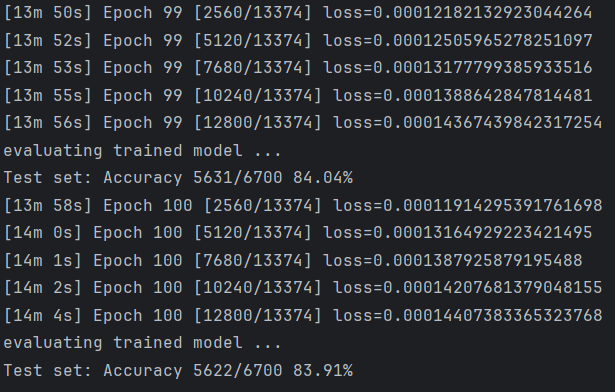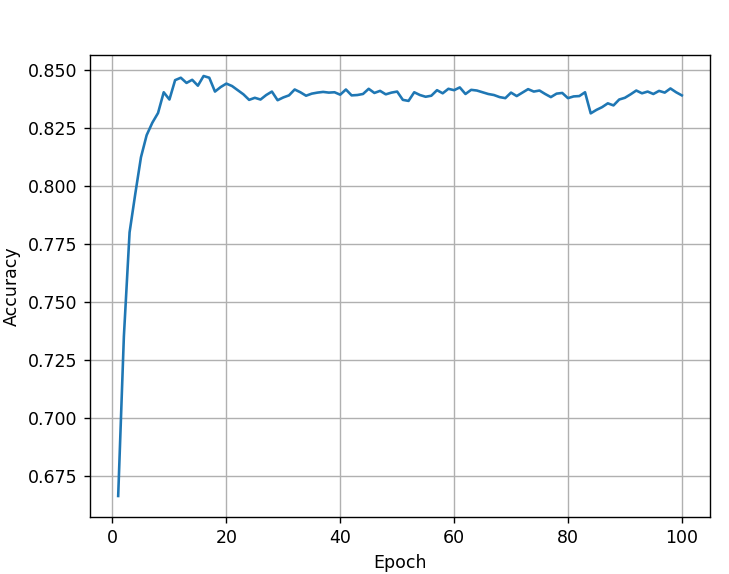Appearance
RNN Classifier
有点焦虑,有更想做的事情,所以匆匆结束了,这一节并没有好好看,以后有机会再重刷一次吧。
We shall train on a few thousand surnames from 18 languages of origin, and predict which language a name is from based on the spelling.
模型如下:
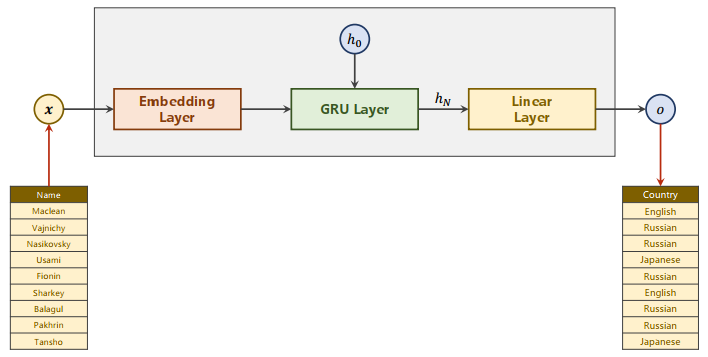
Implementation
Main Cycle
if __name__ == '__main__':
classifier = RNNClassifier(N_CHARS, HIDDEN_SIZE, N_COUNTRY, N_LAYER)
if USE_GPU:
device = torch.device("cuda:0")
classifier.to(device)
criterion = torch.nn.CrossEntropyLoss()
optimizer = torch.optim.Adam(classifier.parameters(), lr=0.001)
start = time.time()
print("Training for %d epochs..." % N_EPOCHS)
acc_list = []
for epoch in range(1, N_EPOCHES + 1):
# Train cycle
trainModel()
acc = testModel()
acc_list.append(acc)如果希望知道训练时间的话,需要记录一下开始的时间start,然后结束训练时调用以下方法:
def time_since(since):
s = time.time() - since
m = math.floor(s / 60)
s -= m*60
return '%dm %ds' % (m, s)将准确率acc都记录到列表中,最后就可以进行绘图:
import matplotlib.pyplot as plt
import numpy as np
epoch = np.arange(1, len(acc_list)+1, 1)
acc_list = np.array(acc_list)
plt.plot(epoch, acc_list)
plt.xlabel('Epoch')
plt.ylabel('Accuracy')
plt.grid()
plt.show()Preparing Data
Name的处理
- 把Name处理成字符序列
- 制作词典,都是英文字符可以直接利用ASCII码
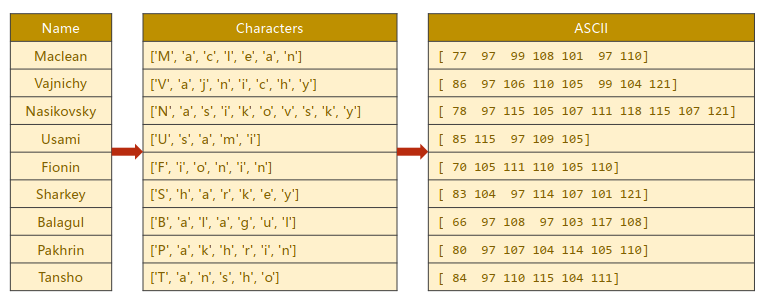
- 注意到序列的长度长短不一,因此还需要进行padding
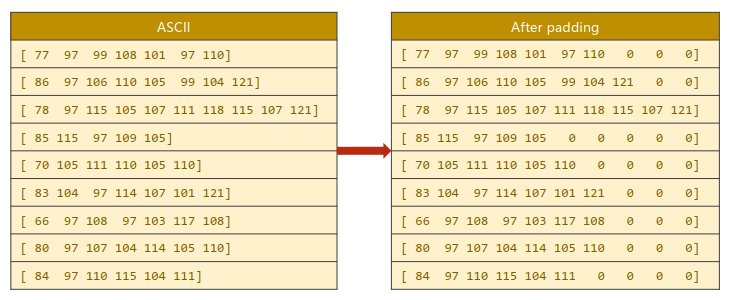
Country的处理
把国家转化为分类索引
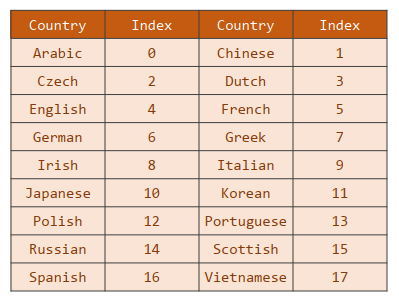
代码
# Parameters
HIDDEN_SIZE = 100
BATCH_SIZE = 256
N_LAYER = 2
N_EPOCHS = 100
N_CHARS = 128
USE_GPU = True
# Prepare Data
class NameDataset(Dataset):
def __init__(self, is_train_set=True):
filename = 'data/names_train.csv.gz' if is_train_set else 'data/names_test.csv.gz'
with gzip.open(filename, 'rt') as f:
reader = csv.reader(f)
rows = list(reader)
self.names = [row[0] for row in rows]
self.len = len(self.names)
self.countries = [row[1] for row in rows]
self.country_list = list(sorted(set(self.countries)))
self.country_dict = self.getCountryDict()
self.country_num = len(self.country_list)
def __getitem__(self, index):
return self.names[index], self.country_dict[self.countries[index]]
def __len__(self):
return self.len
def getCountryDict(self):
country_dict = dict()
for idx, country_name in enumerate(self.country_list, 0):
country_dict[country_name] = idx
return country_dict
def idx2country(self, index):
return self.country_list[index]
def getCountriesNum(self):
return self.country_num
trainset = NameDataset(is_train_set=True)
trainloader = DataLoader(trainset, batch_size=BATCH_SIZE, shuffle=True)
testset = NameDataset(is_train_set=False)
testloader = DataLoader(testset, batch_size=BATCH_SIZE, shuffle=False)
N_COUNTRY = trainset.getCountriesNum()Model Design
class RNNClassifier(torch.nn.Module):
def __init__(self, input_size, hidden_size, output_size, n_layers=1, bidirectional=True):
super().__init__()
self.hidden_size = hidden_size
self.n_layers = n_layers
self.n_directions = 2 if bidirectional else 1
self.embedding = torch.nn.Embedding(input_size, hidden_size)
self.gru = torch.nn.GRU(hidden_size, hidden_size, n_layers, bidirectional=bidirectional)
self.fc = torch.nn.Linear(hidden_size * self.n_directions, output_size)
def _init_hidden(self, batch_size):
hidden = torch.zeros(self.n_layers * self.n_directions, batch_size, self.hidden_size)
return create_tensor(hidden)
def forward(self, input, seq_lengths):
# input shape : B x S -> S x B
input = input.t() # 转置
batch_size = input.size(1)
hidden = self._init_hidden(batch_size)
embedding = self.embedding(input)
# pack them up
gru_input = pack_padded_sequence(embedding, seq_lengths)
output, hidden = self.gru(gru_input, hidden)
if self.n_directions == 2: # 拼接隐层
hidden_cat = torch.cat([hidden[-1], hidden[-2]], dim=1)
else:
hidden_cat = hidden[-1]
fc_output = self.fc(hidden_cat)
return fc_outputBi-direction RNN/LSTM/GRU
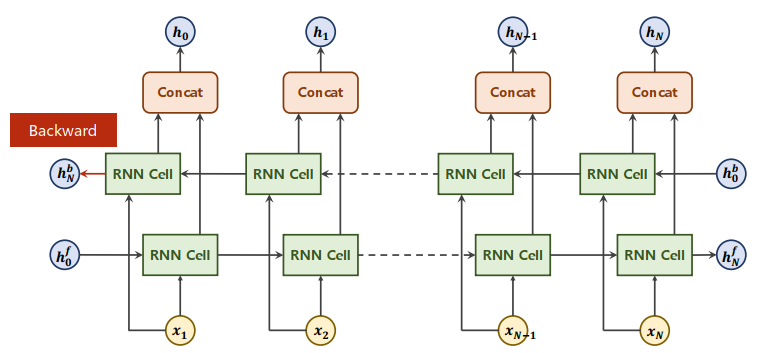
双向循环网络。
把正向与反向的隐层做拼接。
Convert Name to Tensor
def name2list(name):
arr = [ord(c) for c in name]
return arr, len(arr)
def create_tensor(tensor):
if USE_GPU:
device = torch.device("cuda:0")
tensor = tensor.to(device)
return tensor
def make_tensors(names, countries):
sequences_and_lengths = [name2list(name) for name in names]
name_sequences = [sl[0] for sl in sequences_and_lengths]
seq_lengths = torch.LongTensor([sl[1] for sl in sequences_and_lengths])
countries = countries.long()
# make tensor of name, BatchSize x SeqLen
seq_tensor = torch.zeros(len(name_sequences), seq_lengths.max()).long()
for idx, (seq, seq_len) in enumerate(zip(name_sequences, seq_lengths), 0):
seq_tensor[idx, :seq_len] = torch.LongTensor(seq)
# sort by length to use pack_padded_sequence
seq_lengths, perm_idx = seq_lengths.sort(dim=0, descending=True)
seq_tensor = seq_tensor[perm_idx]
countries = countries[perm_idx]
return create_tensor(seq_tensor), \
create_tensor(seq_lengths), \
create_tensor(countries)One Epoch Training
def trainModel():
total_loss = 0
for i, (names, countries) in enumerate(trainloader, 1):
inputs, seq_lengths, target = make_tensors(names, countries)
output = classifier(inputs, seq_lengths)
loss = criterion(output, target)
optimizer.zero_grad()
loss.backward()
optimizer.step()
total_loss += loss.item()
if i % 10 == 0:
print(f'[{time_since(start)}] Epoch {epoch} ', end='')
print(f'[{i * len(inputs)}/{len(trainset)}] ', end='')
print(f'loss={total_loss / (i * len(inputs))}')
return total_lossTesting
def testModel():
correct = 0
total = len(testset)
print("evaluating trained model ...")
with torch.no_grad():
for i, (names, countries) in enumerate(testloader, 1):
inputs, seq_lengths, target = make_tensors(names, countries)
output = classifier(inputs, seq_lengths)
pred = output.max(dim=1, keepdim=True)[1]
correct += pred.eq(target.view_as(pred)).sum().item()
percent = '%.2f' % (100 * correct / total)
print(f'Test set: Accuracy {correct}/{total} {percent}%')
return correct / totalResult
